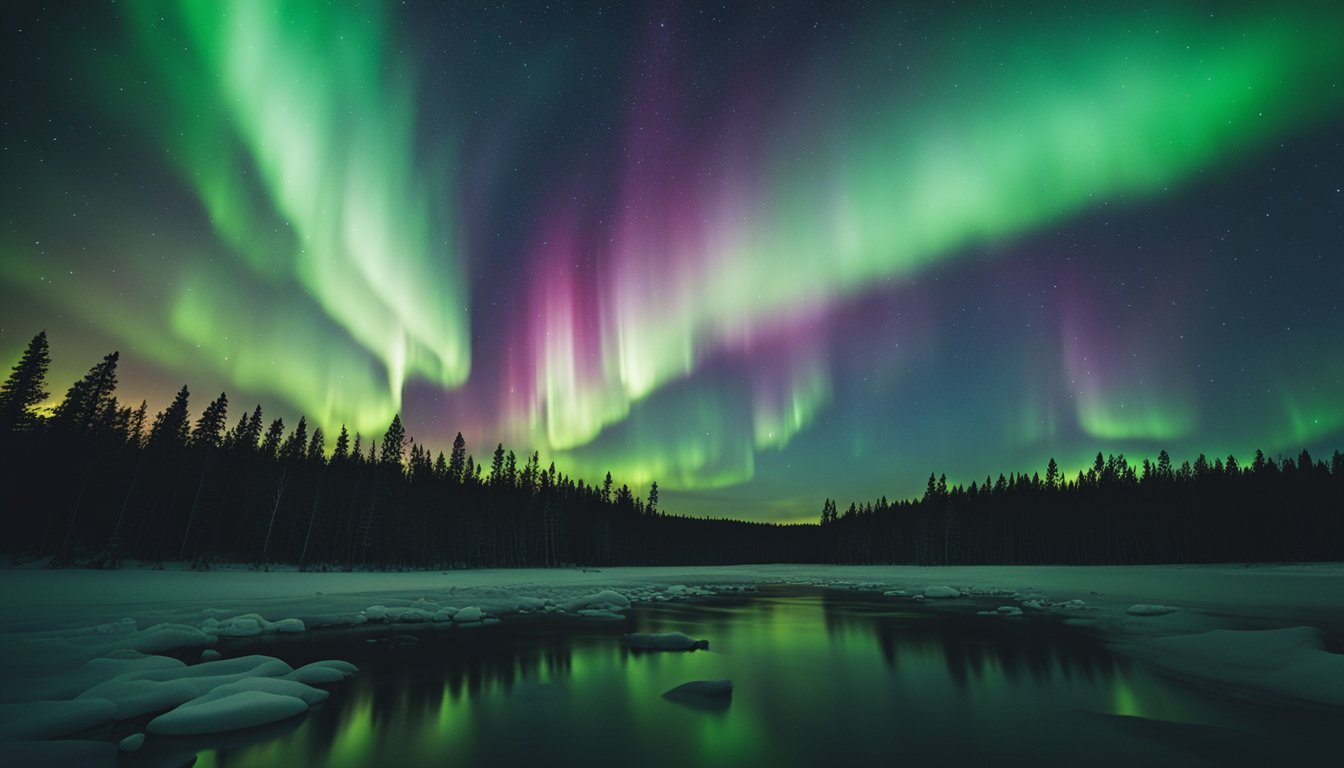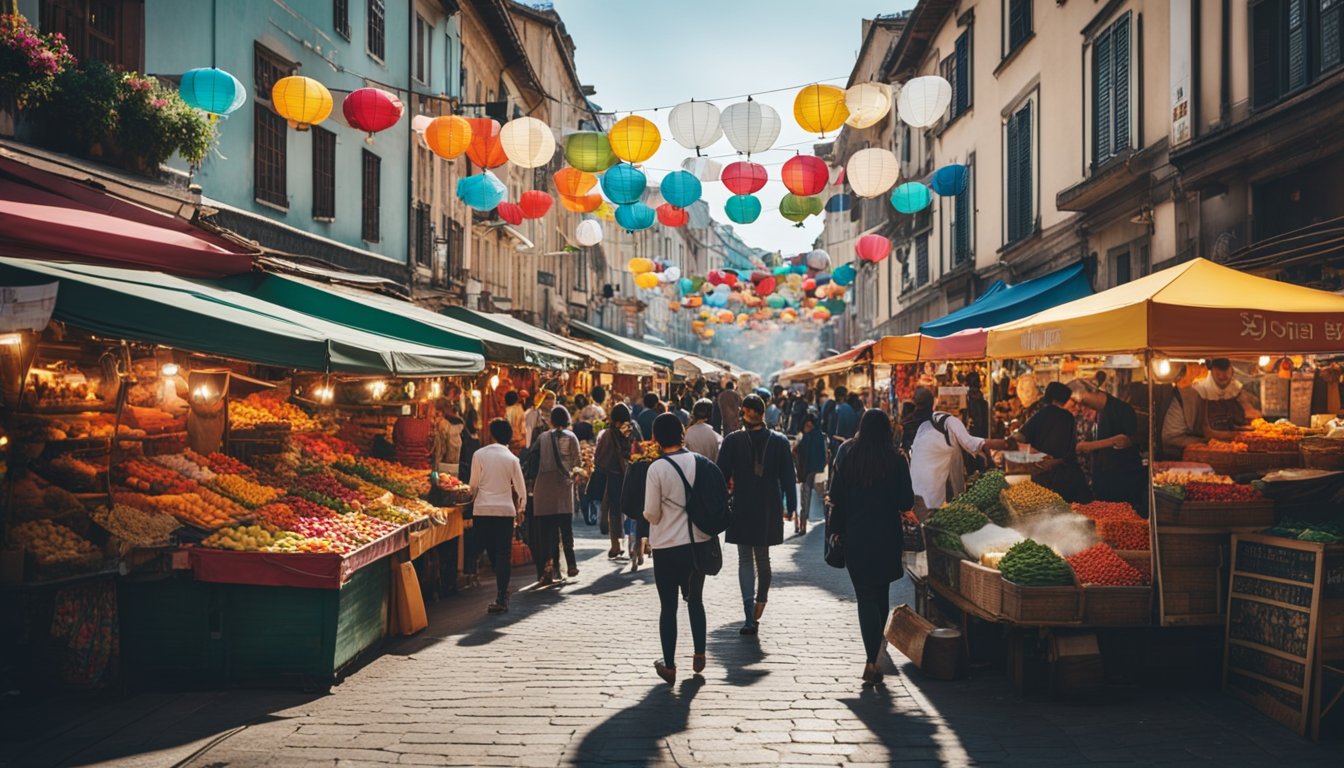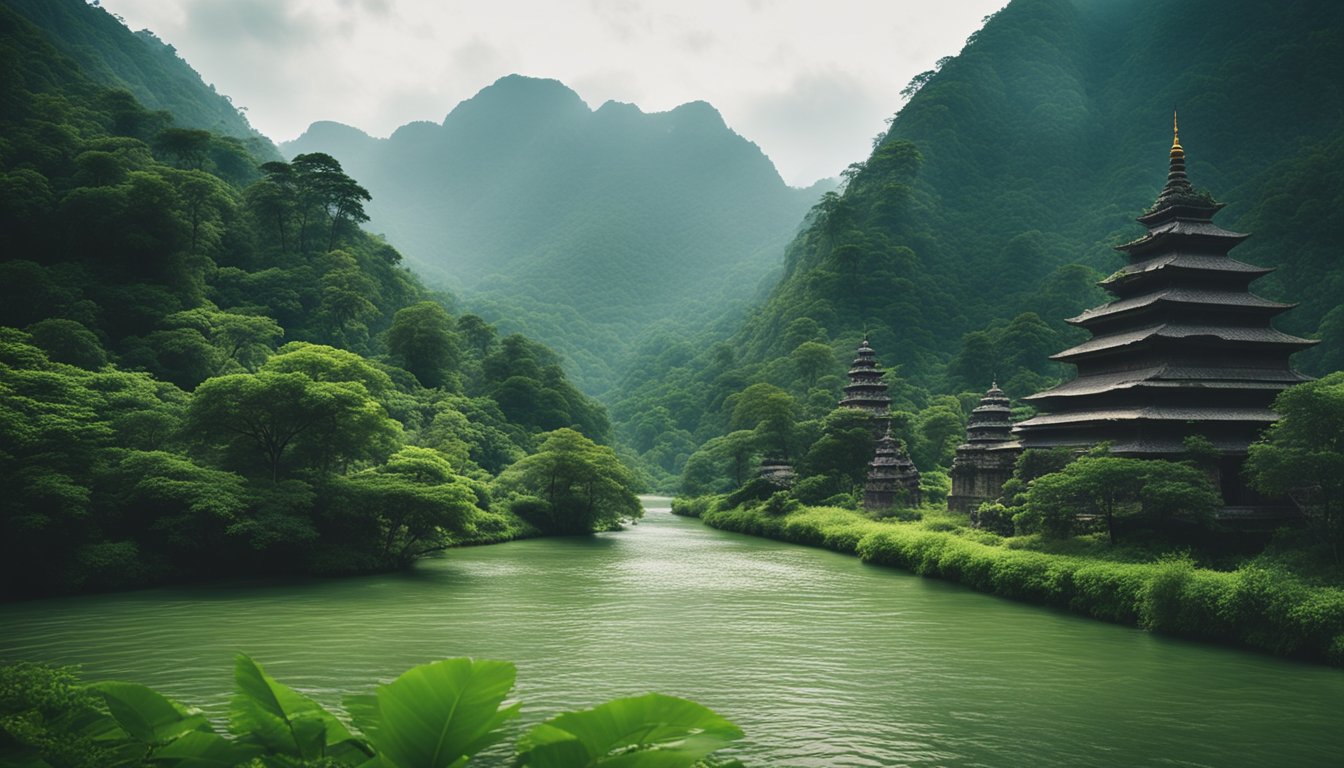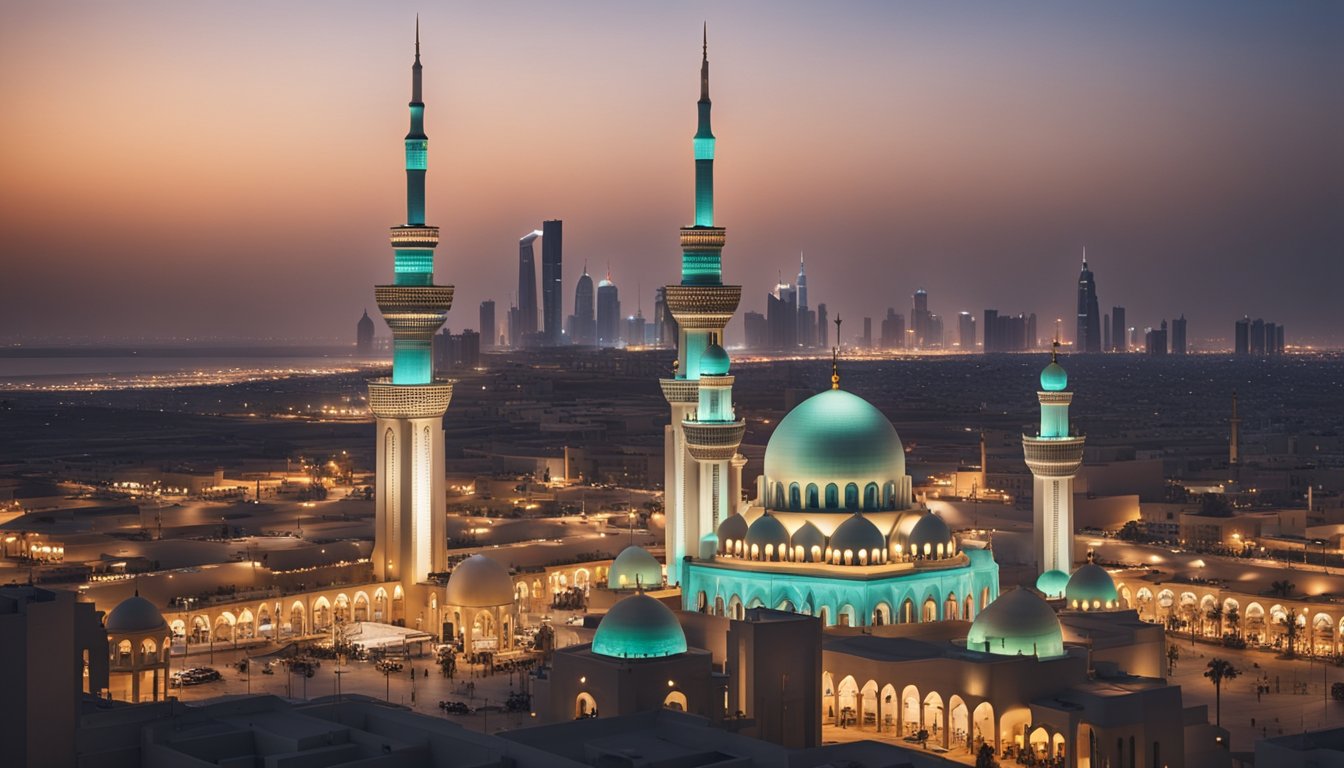The Northern Lights, also known as Aurora Borealis, offer a celestial display of vibrant colors that dance across the polar skies. Finland is one of the premier destinations for witnessing this natural phenomenon, thanks to its geographical location within the “Aurora Zone.” Observers in Finland have the opportunity to see the lights in a variety of settings, from the urban vantage points in cities like Rovaniemi to the remote tranquility of areas like Finnish Lapland.

The best time to experience the Northern Lights in Finland is during the winter months, from September to March, when the nights are longest and darkest. The absence of light pollution is a crucial factor, and in Finland’s northernmost parts, the conditions are optimal due to the vast wilderness areas. Travelers seeking the Aurora are encouraged to plan their visit between late autumn and early spring for the highest chances of a sighting.
Visitors to Finland will find a range of activities and accommodations designed to enhance the Northern Lights experience. From glass igloos and Aurora hunting tours to cultural insights provided by the indigenous Sámi people, the country offers a comprehensive Arctic experience. The Finnish commitment to preserving the natural environment ensures that the beauty of the Northern Lights can be appreciated in a sustainable and responsible manner.
What Are the Northern Lights?

The Northern Lights, or aurora borealis, are a natural light display in the Earth’s sky, predominantly seen in high-latitude regions. The phenomenon is a consequence of interactions between the Earth’s atmosphere and charged particles from the sun.
Science of Aurora Borealis
The aurora borealis is a result of collisions between solar wind particles and atmospheric gases. These solar winds are streams of charged particles often enhanced by solar flares—explosions on the sun’s surface. As the sun’s activity varies, so does the intensity of the auroral displays. Charged particles are drawn towards the magnetic poles of the Earth, and when they collide with oxygen and nitrogen atoms in the atmosphere, they emit light. This light forms the colorful displays known as the Northern Lights.
Key Elements:
- Charged Particles: originate from the sun.
- Solar Flares: increase the intensity of the particles.
- Earth’s Atmosphere: collisions here cause the light.
- Magnetic Poles: guide particles, resulting in auroral displays.
Mythology and Cultural Significance
Throughout history, the aurora borealis has held significant mythological and cultural importance. Various cultures have ascribed different meanings and stories to these lights. In Norse mythology, they were believed to be the reflections of the shields of the Valkyries. The Sami people regarded the auroras as spirits of their ancestors. Across different cultures, the Northern Lights have inspired folk tales and influenced traditional beliefs, often seen as omens or spirits.
Cultural Interpretations:
- Norse mythology: shields of the Valkyries.
- Sami tradition: ancestral spirits.
- Influence on: folk tales, traditional beliefs, and cultural narratives.
Best Times for Northern Lights in Finland

The phenomenon of the Northern Lights, or auroras, is most visible in Finland during dark, clear nights, with specific periods offering higher chances of sightings.
Winter Season (December to February)
During winter, the darkness and snow cover in Finland create ideal conditions for Northern Lights. The best time within this period is from December to February when nights are longest and darkest, giving the aurora borealis ample time to appear. Travelers should monitor the aurora forecast to increase their chances of a sighting.
- Best Months: December, January, February.
- Optimal Conditions: Long, dark nights with clear skies.
- Peak Hours: Between 9 PM and 2 AM.
Spring Equinox (March to April)
The Spring Equinox enhances aurora activity due to changes in the Earth’s geomagnetic field. The first half of March to early April presents a good balance of dark skies and milder weather. This period may sometimes offer clearer nights compared to winter’s snowy backdrop.
- Best Timeframe: March to early April.
- Key Advantage: Increased geomagnetic activity around the equinox.
- Observation Tips: Look for clear skies after dusk.
Autumn Chances (September to November)
Aurora visibility starts to pick up in September as nights grow longer. Though the window is shorter compared to winter, September to November offers darkness without the extreme cold, and the potential for clear skies is often better than during the snowy months.
- Best Months: September, October, November.
- Nightly Window: Post-sunset to before midnight.
- Success Factor: Balancing early nightfall with favorable weather conditions.
Optimal Locations to Experience the Lights

Finland offers some of the most remarkable vantage points for viewing the Northern Lights. They are most vivid from late autumn to early spring, with Finnish Lapland being the premier destination due to its geographical position.
Finnish Lapland
Located above the Arctic Circle, Finnish Lapland is a prime location. Stretches of wilderness and national parks in this region offer free-to-access viewing spots. The area around Sodankylä is especially noteworthy for its clear skies.
Rovaniemi and the Arctic Circle
Rovaniemi, known as the official hometown of Santa Claus, is also a recognized Northern Lights viewing spot. It sits right on the Arctic Circle, providing a balance of accessibility and authentic Lapland experience.
- Best Viewing Times: September to March
- Accessibility: Good, with options for guided tours
Kakslauttanen and Saariselkä
These areas are famous for their glass igloos, allowing visitors to watch the auroras in comfort. Kakslauttanen Arctic Resort near Saariselkä offers a unique accommodation experience with clear views of the night sky.
- Unique Feature: Overnight stays in glass igloos
- Nearby Attractions: Urho Kekkonen National Park
Remote Northern Lapland
For the adventurous, remote regions like Utsjoki provide undisturbed views of the auroras. The northernmost areas of Finland boast some of the darkest skies, ideal for Northern Lights experiences.
- Suggested Areas: Utsjoki, Kevo Strict Nature Reserve
- Consideration: Limited services, best suited for experienced wilderness enthusiasts
Lodging and Viewing Experiences

Finland offers unique accommodations that cater to the optimal viewing of the Northern Lights, with options ranging from luxurious glass igloos to rustic log cabins located in areas with low light pollution.
Glass Igloos and Villas
Kakslauttanen Arctic Resort and similar destinations provide guests with the opportunity to stay in glass igloos or villas. These structures are designed with thermal glass ceilings to offer clear views of the Northern Lights from the comfort of one’s bed. Due to their remote locations, such as Aurora Village, there is minimal light pollution, enhancing the aurora viewing experience.
- Locations: Kakslauttanen, Aurora Village, Rovaniemi
- Best Feature: Unobstructed sky views from bed
- Ideal Time: During darkness of Arctic evenings
Log Cabins and Resorts
Traditional log cabins provide a cozy atmosphere for aurora chasers. Resorts like the Kakslauttanen Arctic Resort offer cabins equipped with amenities that ensure a comfortable stay. These cabins are typically situated in areas with low light pollution to maximize the visibility of the Northern Lights.
- Accommodations: Private cabins with modern conveniences
- Night-Time Ambience: Serene, surrounded by nature’s quiet
Wilderness Excursions
For adventurers, wilderness excursions offer a more immersive experience. Guided tours can lead guests to remote locations, away from any forms of artificial light, increasing the chances of a spectacular Northern Lights display. These excursions often involve overnight stays in temporary igloos built specifically for this purpose.
- Experience: Guided tours, tailored to chasing the aurora
- Note: Limited amenities, closer connection with nature
Activities Under the Northern Lights

Viewing the Northern Lights in Finland is an unforgettable experience enhanced by engaging in various winter activities. Each activity offers a unique perspective of the natural phenomenon and provides an authentic connection to the Arctic environment.
Snowmobiling and Dog Sledding
- Snowmobiling: Travelers can traverse the Finnish terrain on snowmobiles which offer a thrilling way to explore vast snowy landscapes with the Northern Lights overhead. Guided tours are available, typically starting at dusk to increase chances of sighting the Aurora Borealis.
- Dog Sledding: An iconic winter activity, dog sledding allows guests to witness the Northern Lights while being pulled through the snow by a team of huskies. This intimate immersion into nature embodies a traditional Lapland experience, appealing to those who have such an adventure on their bucket list.
Reindeer Safaris and Ice Fishing
- Reindeer Safaris: Visitors can embark on a magical journey beneath the Northern Lights with a reindeer-led safari. These safaris connect participants to the local Sami culture while offering a serene way to observe the night skies draped in colorful lights.
- Ice Fishing: For a tranquil Northern Lights experience, ice fishing presents a chance to relax by a frozen lake. Equipped with fishing gear and surrounded by silence, one might glimpse the Aurora as they wait for a catch—a quintessential Finnish nature activity for winter enthusiasts.
Snowshoeing and Skiing
- Snowshoeing: Engaging in snowshoeing gives nature lovers a unique opportunity to walk through untouched snow under the Arctic sky. This peaceful activity is suitable for all fitness levels and allows for intimate encounters with the Northern Lights.
- Ski Resorts: Finland’s ski resorts often provide nighttime skiing opportunities with well-lit slopes for those who wish to combine their passion for skiing with Aurora viewing. Resorts like Levi and Ruka are renowned for their amenities and proximity to Northern Lights viewpoints.
Photographing the Aurora Borealis

Photographing the Aurora Borealis requires the right equipment and settings to effectively capture its vibrant colors and movement. The following subsections provide specific advice on camera setup and photography techniques ideal for aurora-hunting endeavors.
Camera Settings and Equipment
One must equip themselves with a DSLR or mirrorless camera capable of manual mode, allowing control over ISO, aperture, and shutter speed. A tripod is crucial to stabilize the camera during long exposures required for capturing the aurora’s colors.
Here’s a basic table of recommended camera settings to start with:
| Setting | Suggested Value |
|---|---|
| Mode | Manual |
| ISO | 1600 to 3200 |
| Aperture | f/2.8 or wider |
| Shutter Speed | 5 to 15 seconds |
| Focus | Manual, set to infinity |
Adjust ISO upwards if the aurora is faint, but monitor for increased noise. A wide-angle lens is preferred for its broad field of view, covering more of the spectacle. Consider a remote shutter release or the camera’s self-timer to prevent movement when capturing the sighting.
Photography Tips and Best Practices
Scout for a location with minimal light pollution and a clear view of the northern sky. This maximizes the chance of witnessing the aurora’s colors. The prime months are September to March, and the best hours often fall between 10 PM and 2 AM.
When composing a shot, include interesting foreground elements such as trees, water, or mountains. This adds depth and context to the spectacle of lights. They should also be patient as auroras can be unpredictable, and it might take several attempts to photograph a strong display.
Keep an eye on the weather and aurora forecasts to plan photography sessions when conditions are most favorable. Dress warmly in layers, as one may be waiting in the cold for an extended period during their aurora-hunting adventure.
By optimizing camera settings, and utilizing the provided tips, photographers increase their chances of capturing stunning images of the aurora borealis.
Preparation and Practical Tips
When planning to see the Northern Lights in Finland, travelers must consider timely weather forecasts, appropriate clothing, and the use of specialized apps for aurora alerts. These preparations greatly enhance the chance of a memorable sighting.
Weather Forecasting and Alerts
Monitoring weather forecasts is critical because clear skies increase the likelihood of observing the Northern Lights. The Finnish Meteorological Institute provides reliable forecasts, which should be checked regularly leading up to and during a trip. Temperature plays a significant role in planning; it can vary dramatically, often dropping well below freezing.
| Temperature | Description |
|---|---|
| Below -15°C | Very Cold |
| -15°C to 0°C | Cold |
| Above 0°C | Chilly to Mild |
Visitors should sign up for aurora alerts that notify them when conditions are favorable.
Clothing and Gear
The right apparel is essential for comfort and safety, as Finnish winters are harsh. It’s advised to dress in layers, starting with thermal underwear and adding items such as fleece and down jackets. Essential gear includes:
- Headwear: A warm hat that covers the ears
- Gloves: Insulated gloves or mittens
- Footwear: Waterproof boots with thermal lining
- Additional Layers: Scarf, neck gaiter, or face mask for wind protection
Using hand warmers and insulated blankets can add comfort during extended periods outdoors.
Aurora Forecast Apps and Services
Optimal viewing experiences often involve real-time aurora forecasts. There are various apps and services providing alerts on aurora activity. These tools use data from geomagnetic activity forecasts and can guide observers to times with the highest likelihood of an aurora display, although no sighting can be guaranteed.
Some popular apps and services include:
- My Aurora Forecast & Alerts: Offers notifications and forecast probability
- Aurora Borealis Forecast & Alerts: Updates on aurora activity with viewing tips
- AuroraNOW: An app provided by the Finnish Meteorological Institute offering localized aurora information
Travelers should have these apps installed and notifications enabled to stay informed on potential Northern Lights activity.
Cultural and Authentic Finnish Experiences
Seeking authentic Finnish experiences involves exploring vibrant cities, engaging with the indigenous Sami culture, and embracing the tradition of Finnish saunas. These activities provide a deep dive into Finland’s heritage.
Visiting Finnish Cities
Helsinki: As Finland’s capital, Helsinki offers a blend of history and modernity. Visitors can enjoy landmarks such as the Helsinki Cathedral and experience local cuisine at the bustling Market Square. The city’s design shops and museums, like the Design Museum, showcase Finland’s contribution to contemporary design.
Rovaniemi: Known as the official hometown of Santa Claus, Rovaniemi lies just on the Arctic Circle, offering unique experiences such as Santa Claus Village. It’s a place where the magic of Christmas can be experienced year-round, complete with a post office that receives letters for Santa from all over the globe.
Oulu: Oulu combines nature with technology, home to a vibrant tech community and a beautiful archipelago. The city is also known for events like the Air Guitar World Championships, reflecting the quirky side of Finnish culture.
Kemi: This coastal town is famous for the Kemi SnowCastle, a seasonal structure entirely made of ice and snow, and for its gemstone gallery housing the crown jewels of Finland.
Exploring Sami Culture
The Sami people are the only indigenous population in the European Union, mainly residing in the northern regions of Finland. Visitors can immerse themselves in Sami culture by visiting the Siida Museum in Inari, which provides insights into the Sami way of life, including their connection to nature, traditional clothing, and handicrafts. Participating in local festivals or visiting a Sami reindeer farm allows for a more personal experience of the Sami traditions.
Relaxing in Finnish Saunas
The sauna is an essential part of Finnish culture, with the Finnish word “löyly” describing the steam that rises from the stones. There are over 2 million saunas in Finland, signifying their importance. A quintessential experience is enjoying a traditional wood-heated sauna, followed by a refreshing dip in a lake or the Baltic Sea. Public saunas, like Löyly in Helsinki and Rajaportin sauna in Tampere, provide an opportunity to enjoy this Finnish tradition in a social setting.
When Not to Visit for Northern Lights
To optimize the chances of witnessing the Northern Lights in Finland, certain times of the year are less favorable due to natural and artificial factors affecting visibility.
Midnight Sun and Summer Months
During the summer months, especially from late May to late July, the phenomenon known as the midnight sun prevents the Northern Lights from being visible. It is a period when the sun remains visible at midnight, keeping the skies too bright to observe any auroras. This effect is more pronounced the further north one goes, with almost continuous daylight in Arctic winter areas. August marks the end of the midnight sun period, but visibility is still reduced due to lingering twilight hours.
Challenges in Southern Finland
In Southern Finland, the proximity to urban centers introduces significant artificial lights which can impede the viewing of the Northern Lights. Even during the darker months, the bright lights from cities create light pollution that reduces the chances of seeing the auroras. Additionally, the Northern Lights are less frequently visible in the south compared to northern regions of Finland. While visitors may seek the experience during the ruska season, which is the autumn leaf color season, the optimal conditions for witnessing the Northern Lights are more likely as winter deepens and nights grow longer.
Frequently Asked Questions
This section helps travelers gain clarity on when to visit Finland for the Northern Lights, what services to use for the best experience, and the scientific phenomena behind the auroral displays.
Best Time for Guaranteed Sightings
The Northern Lights, or auroras, are most likely to be seen in Finland from February to March. This is due to heightened solar activity, which generates more solar wind and solar flares, interacting with Earth’s atmosphere to produce the lights. For the highest chance of witnessing this natural spectacle, one should plan to visit during these months.
Booking Tours and Local Guides
Booking a guided tour enhances the experience of chasing the Northern Lights. Local guides are well-versed with the prime locations and times for viewings. They adjust the tour based on the space weather forecast to improve the odds of a successful sighting. Here is a basic structure of what to expect when booking a tour:
- Pre-tour: Information session on auroras
- During the tour:
- Transportation to various viewing spots
- Photography tips and assistance
- Post-tour: Follow-ups on photographs and overall experience
Understanding the Science of Auroras
Auroras are the result of complex interactions between the Earth’s magnetic field and solar particles. They occur when:
- Solar winds carry charged particles towards Earth.
- These particles collide with atmospheric gases.
- Energy is released in the form of light, seen as the Northern Lights.
Finland’s location in the auroral oval, a zone with frequent auroral activity, makes it an excellent place to observe this majestic natural phenomenon directly related to space weather patterns.
Conclusion
Witnessing the Northern Lights, with their ethereal dance across the Finnish sky, is unequivocally a memorable experience. Finland, notably Lapland, offers some of the most optimal viewing conditions from September to March when the nights are longest.
Visitors to Finland should prepare for the northern lights with both patience and an awareness of local forecast patterns. While their appearance can never be guaranteed, the chances increase with the right planning and timing.
The experience of the northern lights remains a highlight on the bucket list of many travelers. It is not merely a visual spectacle but a fully immersive encounter with nature’s astonishing phenomena.
The allure of the auroras draws visitors to Finnish locales such as Rovaniemi, Luosto, and Kakslauttanen. Each offers distinct vantage points for witnessing this natural marvel.
| Prime Locations in Finland | Optimal Months |
|---|---|
| Rovaniemi | September-March |
| Kakslauttanen | September-March |
| Ivalo | September-March |
For the intrepid souls seeking to behold the northern lights, Finland beckons with its pristine Arctic landscapes and dark, clear nights. Each person’s journey to this corner of the world is rewarded with more than just the possibility of the lights—the pure and serene beauty of Finland’s environment is an experience unto itself.



